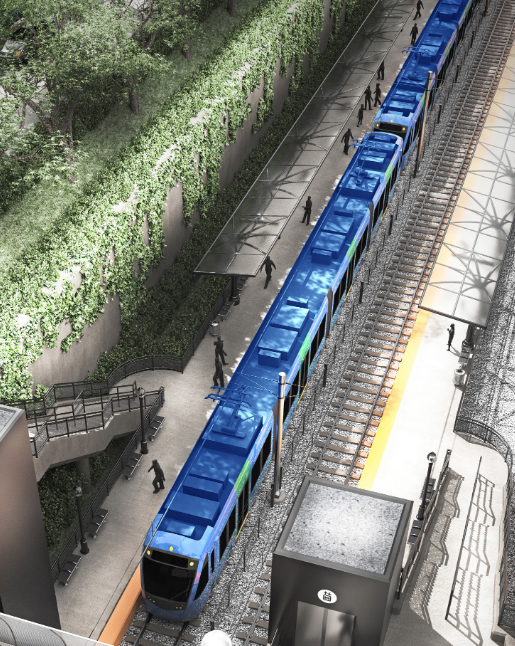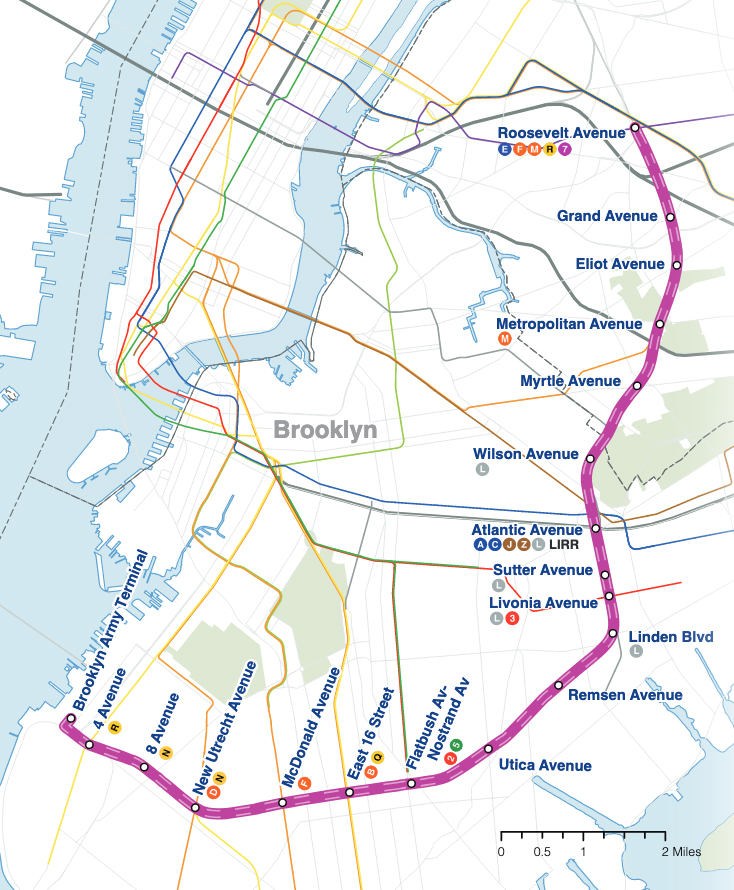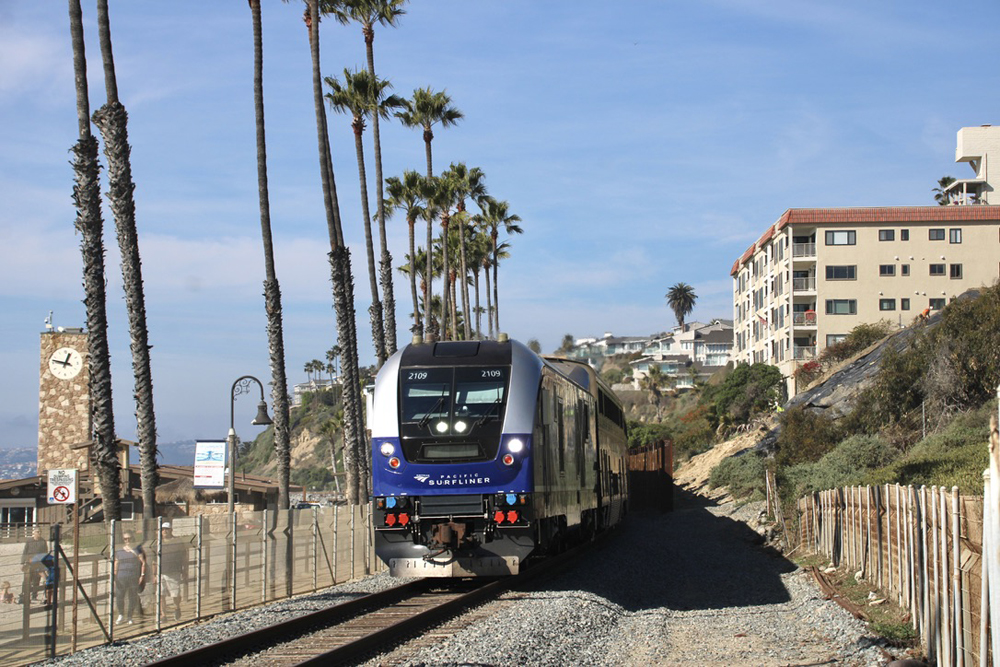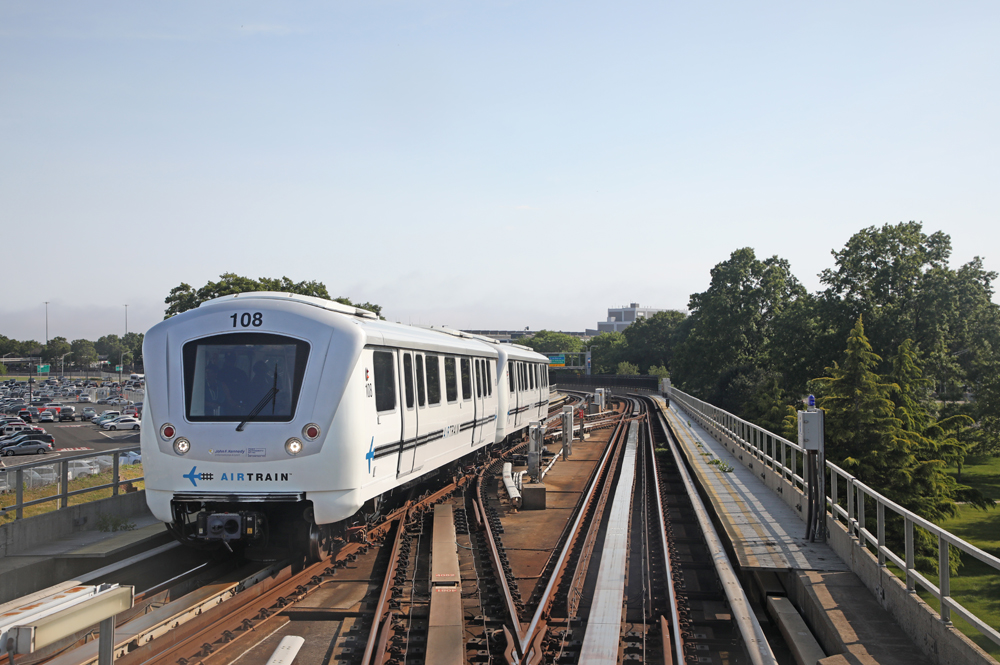
NEW YORK — Consultant WSP USA will perform the environmental review for the Interborough Express, the proposed 14-mile light rail line in Brooklyn and Queens which will use the right-of-way of Long Island Rail Road’s Bay Ridge Branch for a route connecting 17 subway lines and LIRR commuter rail service.
The Metropolitan Transportation Authority also announced it will hold a virtual town hall meeting on the project on Aug. 16.
New York Gov. Kathy Hochul announced WSP’s selection, saying it “marks a major milestone in this monumental project, bringing us that much closer to connecting communities in Brooklyn and Queens while improving their quality of life. By building on already existing infrastructure, the Interborough Express will shave time off commutes and make it easier to connect to subway lines across the route.”
WSP USA’s contract will govern the period up to and including the issuance of a Record of Decision on the environmental impact, and will include further advancement of conceptual design and general planning support; preparation of the Environmental Impact Statement; support at hearings on that statement, and support for preliminary engineering and applications for the Federal Transit Administration Capital Investment Grant program. The work will be directed by MTA Construction & Development.
“The Interborough Express will create seamless connections to jobs, housing, and everything the metropolitan region has to offer,” said Jamie Torres-Springer, president of MTA Construction & Development. “Awarding a contract for the environmental review brings us one step closer to making this project a reality.”
The light rail line will be the first in the MTA system. Light rail was chosen over heavy-rail and bus rapid transit options earlier this year [see “MTA to build first light rail line …,” Trains News Wire, Jan. 12, 2023].
The online town hall meeting, part of ongoing public outreach plans, will review actions on the project so far, including the Planning and Environmental Linkages Study. It will be held Aug. 16 from 6:30 p.m. to 7:30 p.m. EDT. Those interested in taking part can sign up here; more information on the project is available here.















Passenger service on the Bay Ridge Branch was discontinued in 1924. It was electrified for the New Haven to use as a shortcut of the Maybrook line over the Poughkeepsie Bridge for traffic from the south over the PRR. The only drawback was the float barges across the Upper Bay from Greenville. The line that the line over Jamaica Bay connected to is the original Montauk Branch which lost passenger service in 1998 partially due to redundancy and having no direct connection to Penn Station. It was mainly used for trains to and from the Long Island City station.
They should extend line to Laguardia airport
LGA is being rebuilt at God knows what cost, but no one has figured out how to get passengers to it. Robert Moses, New York’s anti-transit development czar, lives on decades after his death.
And this plan while it is a great one will never come to reality. Too many factors going against it. For the customers who are serviced by freight trains are going to oppose it and maybe some NIMBYS who live nearby will protest it and try to stop it from ever being built. Labor costs and materials as well as construction costs as well as competive bidding will also factor into this and either drive up the costs and further delay it ever being built or placed in service. If this is to be built with federal funds forget it. With the present bunch we have in Congress and whose only mission is to slash and burn and cut spending down to a bare bones budget, they will never allocate funds for its construction. New York City might have better luck and results hiring the people who constructed Brightline to do the job. At least they will build it and possibly have a system that can accomdate both freigh and passenger service. Money is now being wasted on an environmental impact study when the line will be electrified with clean energy efficent equipment. Brookly and Queens need a decent crosstown transit option which is lacking. Only the G line running between Queens Plaza and Church Avenue in Brooklyn is the only crosstown option for residents and service on that line can be an issue at times. By the way for anybody who reads this column and is from New York City and especially Queens, there is an abandoned line that the Long Island Railroad ran from Penn Station along 100th Street out to the Rockaways and served the neighborhoods of Rego Park, Woodside, Forest Hills, Ozone Park and Richmond Hill before heading out to the Rockaways. When the LIRR abandoned that service after selling the portion of the line going over Jamaica Bay to the City of New York because of numerous washouts and storms wreaking havoc on the trestle and straining theLIRR’s operating budget. The northern portion of the line was abandoned and has been that way for over 60 years Attempts then and even now are once again being made to revive service on that line and which would also be a good connector to the various subway lines in the area as well as providing a one seat direct trip into Manhattan. However oppostion from theNIMBYs have stopped anything from going forward. This Interborough connector is a great idea and sorely needed but it has to overcome many hurdles before and if it truly becomes a reality. The consulting firm doing this impact study, like so many consulting firms will make a handsome profit for themselves and most likely the only ones benefiting from this idea and study with only more paperwork and plans to show for it
Joseph C. Markfelder
DR. Joseph, yours is a great post (above) but I can’t agree with everything you wrote. Spending is not being slashed and burned, it keeps going up and up and up.
We can make a good case that there should be more funding for programs we think will do the most good. I’m with you on that. Overall spending on garbage programs is out of control. The Republicans have taken the tiniest bite out of it.
This is a perfect example when I made my proposals for LIRR Brooklyn East Branch. Sent my proposal to the Secretary of Transportation Pete Buttigieg expressing great interest in revitalizing the LIRR Bay Ridge Branch. I had a interview with Daniel Rivoli from NY1 News in October 15th, 2019 right in the heart of Brownsville, Brooklyn.
This also gives new opportunities for through services from Moynihan Train Hall, Amtrak, Metro-North Railroad, LIRR and New Jersey Transit. Class 1 Railroad services already established in this system. Time to bring the heavy hits to town.
1. And why is an environmental study required when there exists a right of way already used for rail service?
2. Do the LIRR tracks still exist on the branch? If so, why wouldn’t MTA just use LIRR equipment — after adding stations and probably upgrading trackage to passenger quality?
As to your second question, James: — Through service to existing LIRR lines might be better than light rail. I’m not familiar with this territory but that would be a question to be looked into.
Tracks still exist however they’ve be relegated to freight service only will still be operating along side passenger service. There are several points along the route with customers still unitizing freight service, from scrap metal recycling to plastics fabrication, and other commodities sent from Bayridge yard to further points on Long Island. I believe initially rail service was terminated due to an accident with the mix use of passenger and freight. Personal I think going light rail is just to say hey… Look we have a light rail line as opposed to using heavier rail line bring back LIRR service or incorporating subway rolling stock. This this doesn’t help with interoperability and only furthers to increase cost which this line will not cover with its proposed service for much of the route is either industrial, suburban (car dependent) and doesn’t coincide with AM commuting habits.
Here’s what the study will find: that the cost of disabled access to the numerous subway/ LIRR platforms will be enormous.
Disabled access to the light rail itself might be relatively simple at some locations, as pedestrian (bicycle, wheelchair) can cross the tracks at grade. Disabled access to subways, which means stairs and elevators at each side of each location, don’t come cheap.